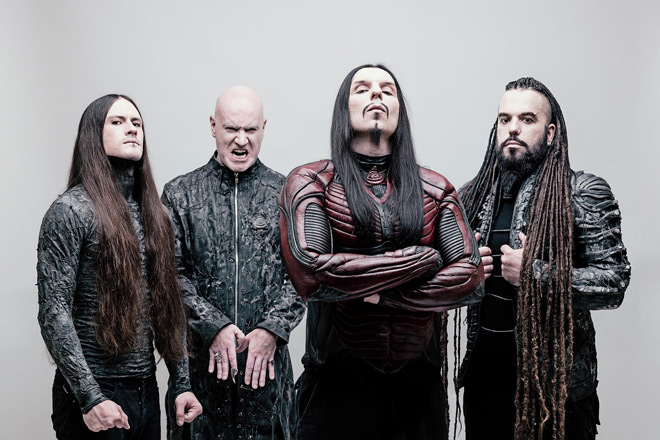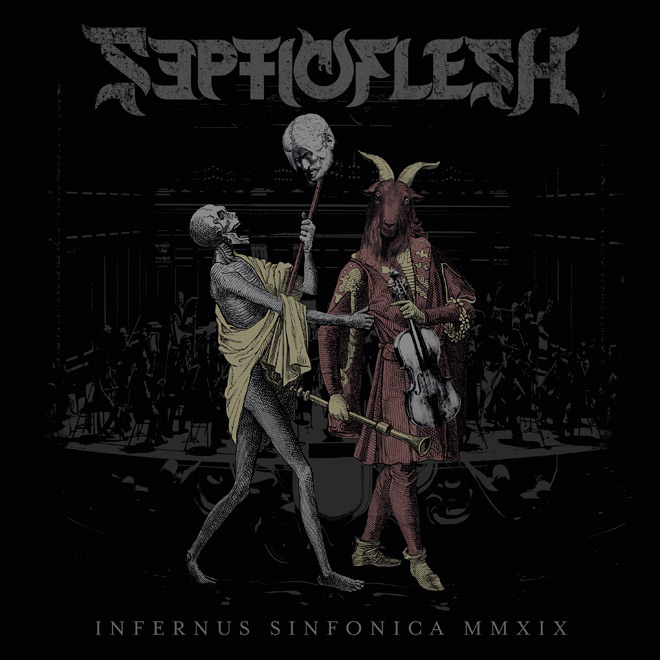
A live effort, it was filmed in February 2019 within the legendary confines of the Teatro Metropólitan in Mexico City. Additionally, the event included over 100 musicians spread across the Symphonic Experience Orchestra, the Enharmonía Vocalis Choir, and the’National University of Mexico Children’s and Youth Choir. Joined by these spirited guests are the usual guilty parties: Spiros “Seth” Antoniou leads the show on vocals and bass, surrounded by his brother Christos and Dinos Prassas on guitar, Sotiris Vayenas on clean vocals, guitar, and keyboards, and Kerim Lechner, the freshest member, handling drums.
Halved by a five-year split, Septicflesh have two distinct periods; the strength of their 1994 debut Mystic Places of Dawn carried them through 2003’s Sumerian Daemons, after which the band scattered into various overlapping projects. The band reformed in 2008 with an new name (the first iteration of the band was spaced as Septic Flesh) and a new label, Season of Mist, who saw fit the release of four further albums, each employing the band’s unique combination of Death Metal guitar/vocals, haunting symphonic elements, and, since the reformation, a distinct electronic undertow. In line with the band’s recent live output, Infernus Sinfonica MMXIX covers only this second act: from 2008’s Communion, to 2011’s The Great Mass, 2014’s Titan, and most recently, 2017’s Codex Omega, all on Season of Mist.
All these factors laid out, from the opening introduction to “Portrait of a Headless Man,” the first full track offered by the band, there is something raucously odd about a Metal band based in Athens, the cradle of civilization, traveling to Mexico City, bringing their loud raging anger to a crowd drowning in historical Catholicism.
Case in point, a video for “The Vampire from Nazareth” was released, visually and aurally highlighting the local musicians recruited for this concert; the follow-up track is listed as “Dogma of Prometheus,” combining the adjacent Titan tracks “Dogma” and “Prometheus,” pulling liberally liberally from only the latter, leaving the heavy dirge of the former back on the source album. The choral chants of “Deus ex Machina” are just about the only vocals from Seth that rise above the musical din, before he slips into a clean speaking voice to entice the crowd into throwing “those fucking devil horns,” a refrain that peppers nearly every song in the set.
As the songs jump between the rebirth of Communion, in particular its opener, “Lovecraft’s Death,” and the seasoned and layered work of Titan and Codex Omega, the growth of the band is on full display. Seth growls in time with the charged choral opening of “Communion,” a nifty addition to an already strong. Later, he performs a similar feat for “Anubis,” a song designed for the live chorus and orchestra employed here; the crowd quickly follows, creating a blissful moil that combines every mind, heart, and throat in the building.
Elsewhere, “Persepolis” has some foreign passages, perhaps native Greek, or even Latin, but the seating arrangement of the Teatro Metropólitan prevents the middle potion of the track from devolving into the “wall of death” left-and-right mosh pit battle that has long been a staple of Septicflesh shows. Instead, the crowd intones, “Burn, burn, burn!” at the direction of Seth. Lastly, “Dark Art” from Codex Omega closes the proceedings, with Seth reminding all his visitors, “we are all the same, we are all the same dark artists/architects…” Oddly enough, the track runs out—perhaps due to time or space constraints—with nary a goodbye from the vocalist, who spends ample time introducing songs and inciting the crowd.
Overall, Infernus Sinfonica MMXIX is an excellent introduction to new fans of the band, and for existing fans, it serves as a strong, decisive presentation of their material in the best possible venue. A dip back into the band’s past, even something as adjacent as Sumerian Daemons, the album that bridges the two narratives, would have been a nice addition, but the strength of all four albums after the band resumed in 2008 leaves very little room to be disappointed.
Already a band with a dense, sweeping catalogs full of classically influenced arrangements, based on years of study by the Antoniou brothers, the live choral and orchestral accompaniment augments rather than obscures the source material. Infernus Sinfonica MMXIX is a strong, well-produced effort, whose only missing piece is perhaps one quick glance back into the band’s formative years, which were equally well-researched and planned. That is why Cryptic Rock gives Infernus Sinfonica MMXIX 4 out of 5 stars.





